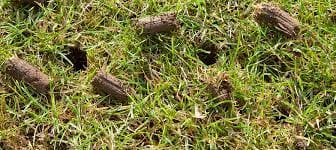How Often Should St. George Residents Aerate Their Lawns?
How often should St. George Residents Aerate Their Lawns?
February through April; The time of year when you start to see those soil plugs laying all over the lawns. Spring is a great time to aerate your lawn because the lawn is coming out of being dormant and it heals quickly from the aeration service before it gets too hot. It also is a great opportunity to get in that first fertilization service so that the nutrients can really penetrate deep into the roots where they need to go to make the grass strong.
But how often should you actually aerate your lawn? Well, that depends a lot on the type of soil you have under your lawn. Clay based soiled should ideally be aerated every year, while sandy soil can stand to wait every 2-3 years to be aerated.
So, how do you know what type of soil you actually have? It’s actually pretty easy to figure out and you don’t need to hire an expensive soil tester to come do it. First, find an empty, clean jar like a mayonnaise or mason jar. Fill the jar about 2/3 full with dirt from your garden. Next, fill the jar with tap water until the jar is almost full, leaving about 1 inch of space at the top. Screw on the lid and shake it vigorously for about one or two minutes, until all the soil is broken down into a suspension in the water.
Allow the jar to sit undisturbed all day and all night. The sand will sink to the bottom, the silt will be on top of the sand, and the clay will float to the top layer. The percentage of each layer tells you what kind of soil you have. You will be able to see the separation and difference between sand, silt, and clay. The sand will be the first to show up, dropping to the bottom within a couple of minutes, and the silt will drop within 5-10 minutes. The clay however will take longer so make sure to leave the jar undisturbed for 24 hours. You might also see some large pieces of compost material on top of the clay. You are not measuring compost material so simply ignore it for this test.
Sandy soil is typically comprised of 80-100% sand, 0-10% silt, and 0-10% clay. Clay soil is typically comprised of 0-45% sand, 0-45% silt and 50-100% clay. If during this experiment you find your sand layer being the largest, you are fine to wait every 2-3 years to receive an aeration service. Getting an aeration service more often will not do damage, however probably unnecessary. However, if your soil experiment shows your top clay level as being the largest, it is important to aerate your lawn yearly so that oxygen and water can move more freely through your soil.

